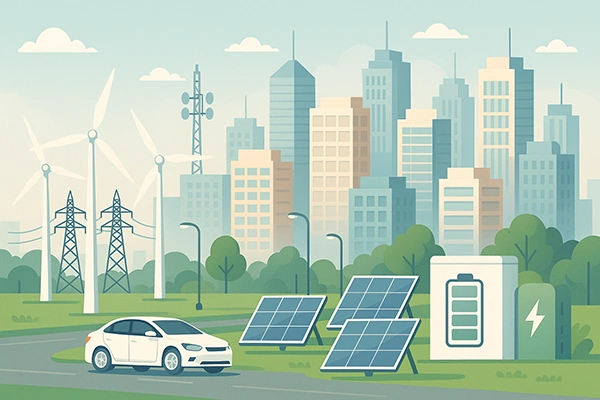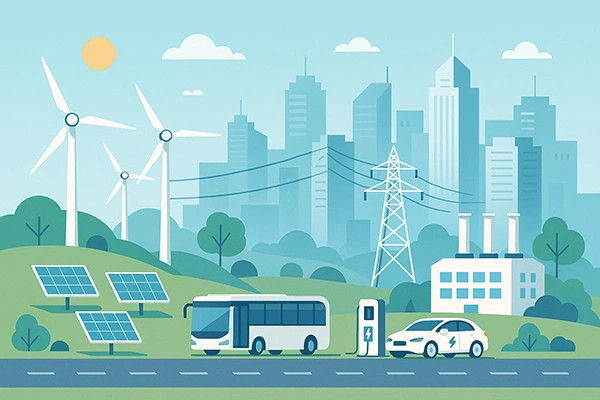
Urban populations are expanding at unprecedented rates globally. By 2050, approximately 68% of the world’s population will reside in cities. Investors monitoring key infrastructure metrics including national grid share price are positioning themselves strategically within this transformation. Smart city development presents substantial opportunities for energy infrastructure investments across multiple sectors.
The convergence of urbanisation and technological advancement creates unique investment landscapes. Infrastructure companies must modernise aging systems while integrating renewable energy sources. This dual challenge offers significant potential returns for informed investors.

Smart cities fundamentally rely on interconnected digital technologies and advanced energy systems. These urban environments utilise Internet of Things (IoT) devices, artificial intelligence, and smart grids. The integration creates efficient resource management and improved quality of life.
Energy infrastructure serves as the backbone of smart city functionality. Traditional power systems require comprehensive upgrades to support increased electricity demand. Cities need flexible, responsive networks capable of managing renewable energy integration.
Key technological components include:
The global smart cities market continues expanding rapidly. Investment flows target projects addressing climate change, resource efficiency, and urban mobility. Government policies increasingly favour sustainable infrastructure development, creating favourable investment conditions.
Private sector participation accelerates through public-private partnerships. These arrangements reduce public funding pressure while providing stable returns. Infrastructure investments typically offer long-term contracts with predictable revenue streams.
National Grid has announced ambitious investment plans totalling £35 billion between 2026 and 2031. This unprecedented infrastructure programme aims to double energy transportation capacity across the UK. The initiative supports renewable energy connections and grid modernisation.
The company’s strategy encompasses several critical areas. Smart meter rollout continues expanding across residential and commercial properties. Grid automation technologies improve system reliability and efficiency. AI investments target operational optimisation and predictive maintenance capabilities.
National Grid’s £100 million commitment to artificial intelligence startups demonstrates forward-thinking approach. These investments focus on companies developing grid management solutions. The initiative supports emerging technologies including digital twins and predictive analytics.
Recent government policy changes support accelerated grid connections. Clean energy projects now receive prioritised access to transmission infrastructure. This policy shift reduces connection waiting times from 15 years to significantly shorter periods.
The transmission upgrade programme includes 3,500 kilometres of overhead line improvements. Additional capacity supports data centre connections and industrial electrification. Battery storage integration provides grid stability during renewable energy fluctuations.
Infrastructure resilience receives increased attention following extreme weather events. Climate adaptation measures protect critical energy assets. These investments ensure reliable service delivery during challenging conditions.
Smart grid modernisation represents the largest investment category within energy infrastructure. Utilities require advanced control systems managing distributed energy resources. These technologies optimise power flows and reduce system losses.
Renewable energy integration creates substantial equipment and service demands. Wind and solar installations need sophisticated connection infrastructure. Grid-scale battery systems store excess renewable generation for later use.
Electric vehicle infrastructure development accelerates across urban areas. Public charging networks require significant capital investment. Smart charging systems integrate with grid management platforms optimising electricity usage.
| Investment Category | Market Size (£bn) | Growth Rate (%) |
| Smart Grid Technology | 12.5 | 8.2 |
| EV Charging Infrastructure | 4.3 | 15.7 |
| Energy Storage Systems | 6.8 | 12.4 |
Data centre expansion drives electricity demand growth significantly. These facilities require reliable, high-capacity connections. Edge computing deployment increases distributed power requirements.
Building automation systems reduce energy consumption while improving occupant comfort. Smart HVAC, lighting, and security systems integrate with broader city management platforms. These technologies offer attractive returns through energy savings.
Cybersecurity solutions protect critical infrastructure from digital threats. Grid modernisation increases vulnerability to cyber attacks. Specialised security technologies command premium pricing within infrastructure markets.
UK government commitment to Clean Power 2030 objectives accelerates infrastructure investment. The target requires massive renewable capacity additions. Grid infrastructure must expand correspondingly to accommodate new generation sources.
Regulatory frameworks increasingly support private infrastructure investment. Revenue mechanisms provide stable, long-term returns for investors. Price controls ensure fair consumer pricing while maintaining investment incentives.
According to recent industry analysis, smart cities consume over 75% of global energy while producing significant greenhouse gas emissions. This statistic highlights the critical importance of efficient urban energy systems.
Climate change concerns drive substantial policy support for infrastructure modernisation. Carbon reduction targets require rapid deployment of clean energy technologies. Investment incentives encourage private sector participation in these initiatives.
International competition for clean technology leadership intensifies investment flows. Countries recognise energy infrastructure as strategic national assets. Government support mechanisms reduce investment risks significantly.
Energy security considerations following recent geopolitical events emphasise domestic infrastructure importance. Reduced dependence on energy imports requires substantial domestic generation and transmission capacity.
Capital intensity represents the primary challenge for energy infrastructure investments. Projects typically require substantial upfront funding with extended payback periods. Financing arrangements must accommodate long development timelines.
Regulatory changes pose ongoing risks to infrastructure investments. Policy shifts can affect project economics significantly. Investors must monitor government priorities and regulatory frameworks continuously.
Technology evolution creates obsolescence risks for infrastructure assets. Rapid advancement may reduce asset values before full cost recovery. Investment strategies should consider technological flexibility and upgrade pathways.
Market competition from international infrastructure providers increases pricing pressure. Global players bring advanced technologies and competitive financing. Domestic companies must maintain technological leadership and operational efficiency.
Economic volatility affects infrastructure demand and financing availability. Interest rate changes impact project economics substantially. Investors should consider economic cycle timing when making infrastructure commitments.
Energy infrastructure investments within smart city development offer compelling opportunities for long-term investors. The convergence of urbanisation, climate policies, and technological advancement creates favourable market conditions. Government support and regulatory frameworks provide additional investment security.
Infrastructure modernisation requirements will persist for decades, ensuring sustained demand. Investors should focus on companies with strong technical capabilities and strategic positioning. Careful risk assessment remains essential given the capital-intensive nature of these investments.
